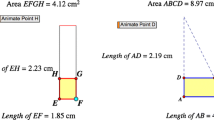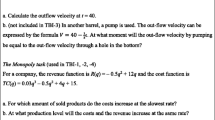Abstract
In this article, we will describe the results of a study of 6th grade students learning about the mathematics of change. The students in this study worked with software environments for the computer and the graphing calculator that included a simulation of a moving elevator, linked to a graph of its velocity vs. time. We will describe how the students and their teacher negotiated the mathematical meanings of these representations, in interaction with the software and other representational tools available in the classroom. The class developed ways of selectively attending to specific features of stacks of centimeter cubes, hand-drawn graphs, and graphs (labeled velocity vs. time) on the computer screen. In addition, the class became adept at imagining the motions that corresponded to various velocity vs. time graphs. In this article, we describe this development as a process of learning to see mathematical representations of motion. The main question this article addresses is: How do students learn to see mathematical representations in ways that are consistent with the discipline of mathematics?
Similar content being viewed by others
REFERENCES
Battista, M. T. (1999). The importance of spatial structuring in geometric reasoning. Teaching Children Mathematics 6(3): 170–177.
Bishop, A. (1989). Review of research on visualization in mathematics education. Focus on Learning Problems in Mathematics 11(1): 7–16.
Casey, E. S. (1987). Remembering. A phenomenological study. Bloomington and India-napolis, IN: Indiana University Press.
Chun, M. M. and Nakayama, K. (2000). On the functional role of implicit visual memory for the adaptive deployment of attention across scenes. Visual Cognition 7(1–3): 65–81.
Clements, D., Nemirovsky, R. and Sarama, J. (1995). Trips©. California: Dale Seymour Publications.
Cobb, P. and Bauersfeld, H. (1995). Introduction: The coordination of psychological and sociological perspectives in mathematics education. In P. Cobb and H. Bauersfeld (Eds), The Emergence of Mathematical Meaning: Interaction in Classroom Cultures. Hillsdale, NJ: Lawrence Erlbaum.
Confrey, J. (1991). Function Probe (Version 2. 3. 9). Santa Barbara, Ca: Intellimation.
Crawford, A. R. and Scott, W. E. (2000). Making sense of slope. The Mathematics Teacher, 93(2): 114–118.
DeLaura. (1996). Baby MathWorlds. North Dartmouth: SimCalc Project.
Dreyfus, T. (1991). On the status of visual reasoning in mathematics and mathematics education. Proceedings of the fteenth Annual Conference of the International Group for the Psychology of Mathematics Education (Assisi), vol. 1, 32–48.
Gibson, J. J. (1972). A theory of direct visual perception. In J. R. Royce and W. W. Ro-zenboom (Eds), The Psychology of Knowing. New York: Gordon & Breach
Goodwin, C. (1994). Professional Vision. American Anthropologist 96(3): 606–633.
Goodwin, C. (1997). The Blackness of Black: Color Categories as Situated Practice. In L. B. Resnick, R. Saljo, C. Pontecorvo and B. Burge (Eds), Discourse, Tools, and Reasoning: Essays on Situated Cognition (NATO Asi Series. Series F, Computer and Systems Sciences, Vol 160). Berlin: Springer-Verlag.
Goody, J. (1977). The Domestication of the Savage Mind. Cambridge, UK: Cambridge University Press.
Healy, L. and Hoyles, C. (1999). Visual and symbolic reasoning in mathematics: Making connections with computers? Mathematical Thinking and Learning 1(1): 59–84.
Horgan, J. (1993). The death of proof. Scientific American (October)92–103.
Intraub, H. (1997). The representation of visual scenes. Trends in Cognitive Sciences 1(6): 217–221.
Jastrow, J. (1900). Fact and Fable in Psychology. Boston: Houghton–Mifflin.
Jordan, B. and Henderson, A. (1995). Interaction Analysis: Foundations and Practice. The Journal of the Learning Sciences 4(1): 39–103.
Kaput, J. J. (1994). Democratizing access to calculus: New routes to old roots. In A. Schoenfeld (Ed. ), Mathematical Thinking and Problem Solving (pp. 77–156). Hills-dale, NJ: Erlbaum.
Kaput, J. J. (1997). SimCalc MathWorlds. North Dartmouth, MA: SimCalc Project.
Kelly, J. A. (1999). Improving problem solving through drawings. Teaching Children Mathematics 6(1): 48–51.
Kohler, W. (1947/1975). Gestalt Psychology. New York: Liveright.
Marton, F. and Booth, S. (1997). Learning and Awareness. Mahwah, NJ: Lawrence Erlbaum.
Nemirovsky, R., & Tierney, C. (2001). Children creating ways to represent changing situations: On the development of homogeneous spaces. Educational Studies in Mathematics 45: 67–102.
Nemirovsky, R., Tierney, C. and Wright, T. (1998). Body Motion and Graphing. Cognition and Instruction 16(2): 119–172.
Noble, T., Nemirovsky, R., Wright, T. and Tierney, C. (2001). Experiencing change: The mathematics of change in multiple environments. Journal for Research in Mathematics Education 32(1): 85–108.
Noss, R., Healy, L. and Hoyles, C. (1997). The construction of mathematical meanings: Connecting the visual with the symbolic. Educational Studies in Mathematics 33(2): 203–233.
Packer, M. J. and Mergendoller, J. R. (1989). The development of practical social understanding in elementary school-age children. In L. T. Winegar (Ed), Social Interaction and the Development of Children 's Understanding (pp. 67–94). Norwood, NJ: Ablex.
Piaget, J. (1946/1970). The Child 's Conception of Movement and Speed (G. E. T. Holloway & M. J. Mackenzie, Trans.). New York: Basic Books.
Poincaré, H. (1905/1952). Science and Hypothesis. New York, NY: Dover Publications.
Presmeg, N. (1986). Visualisation in high school mathematics. For the Learning of Mathematics 6(42–46).
Presmeg, N. (1989). Visualization in multicultural mathematics classrooms. Focus on Learning Problems in Mathematics 11(1): 17–24.
Presmeg, N. (1992). Prototypes, metaphors, metonymies and imaginative rationality in high school mathematics. Educational Studies in Mathematics 23: 595–610.
Rival, I. (1987). Picture Puzzling: Mathematicians are rediscovering the power of pictorial reasoning. The Sciences, 27: 41–46.
Saljo, R. and Bergqvist, K. (1997). Seeing the Light: Discourse and Practice in the Optics Lab. In L. Resnick, R. Saljo, C. Pontecorvo and B. Burge (Eds), Discourse, Tools, and Reasoning: Essays on Situated Cognition (NATO Asi Series. Series F, Computer and Systems Sciences, Vol 160). Berlin: Springer-Verlag.
Schwartz, J. L. and Yerushalmy, M. (1988). The Geometric Supposer. Pleasantville, NY: Sunburst Communications.
Simons, D. J. and Levin, D. T. (1997). Change blindness. Trends in Cognitive Science, 1(7): 261–267.
Stevens, R. and Hall, R. (1998). Disciplined perception: Learning to see in technoscience. In M. Lampert and M. L. Blunk (Eds), Talking Mathematics in School: Studies of Teaching and Learning. Cambridge, UK: Cambridge University Press.
Stroup, W. (1997). Function-Based Algebra: Classroom Activities and Materials. Unpublished manuscript.
Stroup, W. (2002). Understanding qualitative calculus: A structural synthesis of learning research. International Journal of Computers for Mathematical Learning 7: 167–215.
Weiskrantz, L. (1997). Consciousness Lost and Found. Oxford, U.K. Oxford University Press.
Wittgenstein. (1953/1997). Philosophical Investigations (G. E. M. Anscombe, Trans.). Malden, MA: Blackwell.
Yarbus, A. L. (1967). Eye Movements and Vision. New York: Plenum.
Yerushalmy, M. and Chazan, D. (1990). Overcoming Visual Obstacles with the Aid of the Supposer. Educational Studies in Mathematics 21: 199–219.
Yerushalmy, M. and Shternberg, B. (in press). Epistemological and Cognitive Aspects of Time: A Tool Perspective. In R. Nemirovsky and D. Carraher (Eds), Journal for Research in Mathematics Education Monograph CD-Rom Special Issue: National Council of Teachers of Mathematics.
Zeki, S. (1999). Inner Vision: A Exploration of Art and the Brain. Oxford, UK: Oxford University Press.
Zimmerman, W. and Cunningham, S. (1991). Editor 's Introduction: What is Mathe matical Visualization. In W. Zimmerman and S. Cunningham (Eds), Visualization in Teaching and Learning Mathematics (pp. 1–8): Mathematical Association of America.
Author information
Authors and Affiliations
Rights and permissions
About this article
Cite this article
Noble, T., Nemirovsky, R., Dimattia, C. et al. Learning to See: Making Sense of the Mathematics of Change in Middle School. International Journal of Computers for Mathematical Learning 9, 109–167 (2004). https://doi.org/10.1023/B:IJCO.0000040891.50250.7e
Issue Date:
DOI: https://doi.org/10.1023/B:IJCO.0000040891.50250.7e




